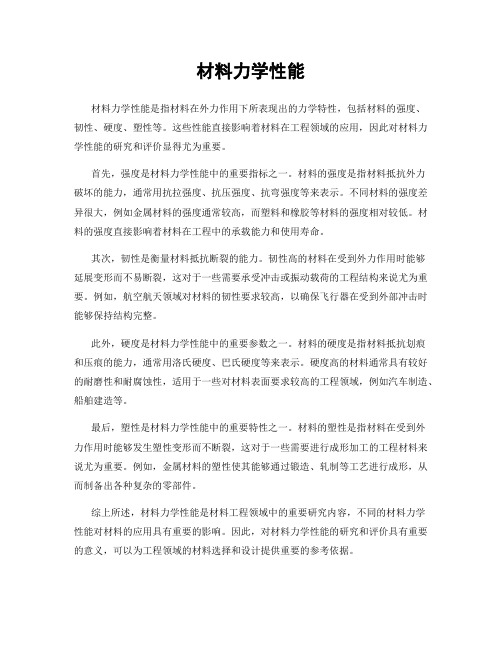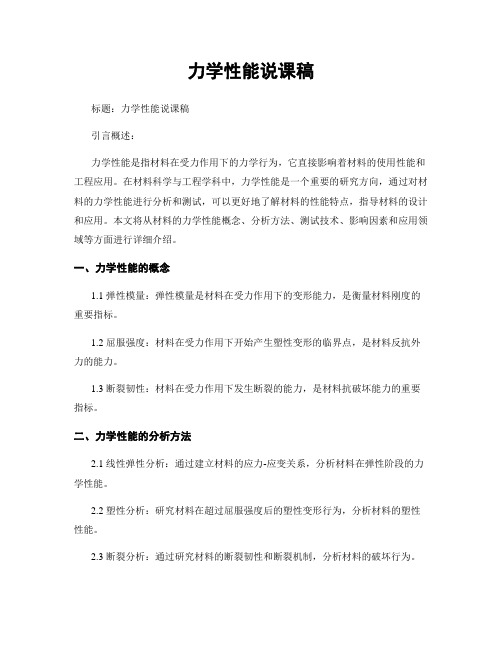材料科学基础-第5章材料力学性能
材料科学基础-第五章1 (1)

=2tc
快速确定具有最大取向因子cosφcosλ的滑 移系方法 映象规则:利用投影图中心部分的八个取向三角形
4. 晶体在滑移时的转动 (rotation)
晶体滑移
滑移面上发生相对位移 晶体转动
在拉伸时使滑移面和滑移方 向逐渐转到与应力轴平行 空间取向发生变化 在压缩时使滑移面和滑移方向 逐渐转到与应力轴垂直
两个阶段
孪生临界切应力比滑移的大得多,只有在滑移很难进 行的条件下才会发生。例如,Mg孪生所需tc4.9~34.3MPa, 而滑移时tc仅为0.49MPa。但孪晶的长大速度极快(与冲 击波的速度相当)有相当数量的能量被释放出来,故常可 听见明显可闻“咔、嚓”声,也称孪生吼叫。
3. 孪生形变的意义
三 扭折 Kink
hcp的Cd压缩时,外力与(0001)面平行, 故在(0001)面的t=0,若此时孪生过程的阻 力也很大,不能进行。为了使晶体的形状与 外力相适应,当外力超过某一临界值时,晶 体将会产生局部弯曲,即出现扭折现象。 扭折区晶体的取向发生了不对称变化。 扭折是为适应外力而发生的不均匀局部塑性变形方式, 对变形起一定的协调作用,使应力得到松弛,使晶体不致发 生断裂。另外由于扭折引起晶体的再取向,即有可能使扭折 带区域中的滑移系处于有利取向,促使晶体形变能力进一步 发挥。 造成扭折的原因是滑移面的位错在局部地区集中,从 而引起的晶格弯曲。
四 塑变的位错机制
1. 滑移的位错机制 根据刚性滑移模型推导出的理论切变强度
tm
G 30
G 2
(G一般为104~105MPa),即使采用修正值
与实测值(约为1~10MPa)之间相差3~4个数量级。
位错概念引入解决这一矛盾。因为位错运动时只要求
其中心附近少数原子移动很小的距离(小于一个原子间距), 因此所需的应力要比晶体作整体刚性滑移时小得多。这样借 助于位错的运动就可实现晶体逐步滑移。
材料科学基础-第5章2013

弹簧元件表示的弹性变形部分 —— 与时间无关,
Voigt-Kelvin 模型—— 描述蠕变回复、弹性后效和弹
E 为松弛常数。
性记忆等过程:
粘弹性变形特点——应变落后于应力—–弹性滞后。 施加周期应力时形成的应力 - 应变曲线回线所包含的
d ( t ) E dt
交变载荷(振动)下吸收不可逆变形功 的能力。虽然这两个名词有时可以混用, 但严格来说循环韧性与内耗是有区别的: 循环韧性——指金属在塑性区内加载时吸 收不可逆变形功的能力——消振性; 内耗——指金属在弹性区内加载时吸收不 可逆变形功的能力。
弹性滞后——表明加载时消耗于材料的变形功大于 卸载时材料回复所释放的变形功,多余的部分变形 功已被材料内部所消耗——内耗现象——用弹性滞 后环的面积度量其大小。
面积——应力循环一周所损耗的能量——内耗。
5.2 晶体的塑性变形
当施加的应力超过弹性极限e时,材料会发生塑性变形——产
生不可逆的永久变形。 大多数多晶体工程材料,变形与各晶粒的变形相关。 一、单晶体的塑性变形 在常温和低温下,单晶体的塑性变形——主要形式为滑移 (Slip);其次有孪晶(Twins)、扭折(Twist)等方式。 高温下,单晶体的塑性变形——主要形式为扩散性变形和晶界 滑动与移动等。 滑移——在切应力作用下,晶体的一部分沿着一定晶面(滑移 面)和一定晶向(滑移方向)相对另一部分发生相对位移的现象。
2014-6-11 材料科学基础CAI教材 曾德长 13
其应力、应变符合Hooke定律——应力去除后应变 回复为零。 粘壶 —— 由装有粘性流体的气缸和活塞组成;活 塞的运动是粘性流动的结果 —— 符合 Newton 粘性 流动定律。 Maxwell模型——解释应力松弛机制:
武理833大纲

武理833大纲
以下是武汉理工大学材料科学与工程833材料科学基础考研的大纲,主要分为以下几个部分:
1. 第一章:原子结构与元素周期表
原子的电子构型和周期表
原子能级和光谱
化学键和分子结构
2. 第二章:分子结构和分子光谱
分子能级和光谱
分子振动和转动光谱
电子光谱和X射线光谱
3. 第三章:晶体结构和晶体物理学基础
晶体结构和晶格振动
热力学基础和相图
晶体生长和缺陷
4. 第四章:固体表面和界面
表面能和表面张力
表面吸附和表面改性
界面现象和界面反应
5. 第五章:材料力学性能
应力和应变行为
材料的弹性、塑性和脆性
断裂和疲劳行为
6. 第六章:材料物理性能
电学性能(导电、介电、热电等)
磁学性能(磁导、磁畴、磁致伸缩等)
光学性能(折射、反射、吸收等)
7. 第七章:材料化学性能
氧化、腐蚀和防护
化学反应动力学和催化作用
电化学和电池性能
8. 第八章:材料制备与合成
熔炼、铸造、轧制等传统制备方法
化学气相沉积、物理气相沉积等薄膜制备技术
溶胶-凝胶法、水热法等特种制备技术
9. 第九章:材料科学中的计算机模拟与计算方法
材料科学中的计算机模拟方法(蒙特卡罗、分子动力学等)材料性能的计算机预测与优化设计
10. 第十章:材料科学前沿进展与展望
新材料、新工艺和新应用的发展趋势
材料科学的未来挑战和机遇。
材料力学性能

材料力学性能材料力学性能是指材料在外力作用下所表现出的力学特性,包括材料的强度、韧性、硬度、塑性等。
这些性能直接影响着材料在工程领域的应用,因此对材料力学性能的研究和评价显得尤为重要。
首先,强度是材料力学性能中的重要指标之一。
材料的强度是指材料抵抗外力破坏的能力,通常用抗拉强度、抗压强度、抗弯强度等来表示。
不同材料的强度差异很大,例如金属材料的强度通常较高,而塑料和橡胶等材料的强度相对较低。
材料的强度直接影响着材料在工程中的承载能力和使用寿命。
其次,韧性是衡量材料抵抗断裂的能力。
韧性高的材料在受到外力作用时能够延展变形而不易断裂,这对于一些需要承受冲击或振动载荷的工程结构来说尤为重要。
例如,航空航天领域对材料的韧性要求较高,以确保飞行器在受到外部冲击时能够保持结构完整。
此外,硬度是材料力学性能中的重要参数之一。
材料的硬度是指材料抵抗划痕和压痕的能力,通常用洛氏硬度、巴氏硬度等来表示。
硬度高的材料通常具有较好的耐磨性和耐腐蚀性,适用于一些对材料表面要求较高的工程领域,例如汽车制造、船舶建造等。
最后,塑性是材料力学性能中的重要特性之一。
材料的塑性是指材料在受到外力作用时能够发生塑性变形而不断裂,这对于一些需要进行成形加工的工程材料来说尤为重要。
例如,金属材料的塑性使其能够通过锻造、轧制等工艺进行成形,从而制备出各种复杂的零部件。
综上所述,材料力学性能是材料工程领域中的重要研究内容,不同的材料力学性能对材料的应用具有重要的影响。
因此,对材料力学性能的研究和评价具有重要的意义,可以为工程领域的材料选择和设计提供重要的参考依据。
材料科学基础A习题答案第5章[1]解析
![材料科学基础A习题答案第5章[1]解析](https://img.taocdn.com/s3/m/5ef3bfa0d0d233d4b14e698a.png)
材料科学基础A习题第五章材料的变形与再结晶1、某金属轴类零件在使用过程中发生了过量的弹性变形,为减小该零件的弹性变形,拟采取以下措施:(1)增加该零件的轴径。
(2)通过热处理提高其屈服强度。
(3)用弹性模量更大的金属制作该零件。
问哪一种措施可解决该问题,为什么?答:增加该零件的轴径,或用弹性模量更大的金属制作该零件。
产生过量的弹性变形是因为该金属轴的刚度太低,增加该零件的轴径可减小其承受的应力,故可减小其弹性变形;用弹性模量更大的金属制作该零件可增加其抵抗弹性变形的能力,也可减小其弹性变形。
2、有铜、铝、铁三种金属,现无法通过实验或查阅资料直接获知他们的弹性模量,但关于这几种金属的其他各种数据可以查阅到。
请通过查阅这几种金属的其他数据确定铜、铝、铁三种金属弹性模量大小的顺序(从大到小排列),并说明其理由。
答:金属的弹性模量主要取决于其原子间作用力,而熔点高低反映了原子间作用力的大小,因而可通过查阅这些金属的熔点高低来间接确定其弹性模量的大小。
据熔点高低顺序,此几种金属的弹性模量从大到小依次为铁、铜、铝。
3、下图为两种合金A、B各自的交变加载-卸载应力应变曲线(分别为实线和虚线),试问那一种合金作为减振材料更为合适,为什么?答:B合金作为减振材料更为合适。
因为其应变滞后于应力的变化更为明显,交变加载-卸载应力应变回线包含的面积更大,即其对振动能的衰减更大。
4、对比晶体发生塑性变形时可以发生交滑移和不可以发生交滑移,哪一种情形下更易塑性变形,为什么?答:发生交滑移时更易塑性变形。
因为发生交滑移可使位错绕过障碍继续滑移,故更易塑性变形。
5、当一种单晶体分别以单滑移和多系滑移发生塑性变形时,其应力应变曲线如下图,问A、B中哪一条曲线为多系滑移变形曲线,为什么?应力滑移可导致不同滑移面上的位错相遇,通过位错反应形成不动位错,或产生交割形成阻碍位错运动的割阶,从而阻碍位错滑移,因此其应力-应变曲线的加工硬化率较单滑移高。
力学性能说课稿

力学性能说课稿标题:力学性能说课稿引言概述:力学性能是指材料在受力作用下的力学行为,它直接影响着材料的使用性能和工程应用。
在材料科学与工程学科中,力学性能是一个重要的研究方向,通过对材料的力学性能进行分析和测试,可以更好地了解材料的性能特点,指导材料的设计和应用。
本文将从材料的力学性能概念、分析方法、测试技术、影响因素和应用领域等方面进行详细介绍。
一、力学性能的概念1.1 弹性模量:弹性模量是材料在受力作用下的变形能力,是衡量材料刚度的重要指标。
1.2 屈服强度:材料在受力作用下开始产生塑性变形的临界点,是材料反抗外力的能力。
1.3 断裂韧性:材料在受力作用下发生断裂的能力,是材料抗破坏能力的重要指标。
二、力学性能的分析方法2.1 线性弹性分析:通过建立材料的应力-应变关系,分析材料在弹性阶段的力学性能。
2.2 塑性分析:研究材料在超过屈服强度后的塑性变形行为,分析材料的塑性性能。
2.3 断裂分析:通过研究材料的断裂韧性和断裂机制,分析材料的破坏行为。
三、力学性能的测试技术3.1 拉伸试验:通过施加拉力来测试材料的弹性模量、屈服强度和断裂韧性等力学性能。
3.2 压缩试验:通过施加压力来测试材料在受压状态下的力学性能。
3.3 弯曲试验:通过施加弯曲力来测试材料的弯曲强度和断裂韧性等力学性能。
四、影响力学性能的因素4.1 材料的组织结构:材料的晶粒大小、晶界密度、位错密度等组织结构对力学性能有重要影响。
4.2 温度和环境条件:温度和环境条件对材料的力学性能有明显影响,如高温会降低材料的强度和韧性。
4.3 加工工艺:材料的加工工艺会影响其组织结构和晶粒大小,进而影响力学性能。
五、力学性能的应用领域5.1 材料设计:通过对材料的力学性能进行分析,可以指导材料的设计和选择,提高材料的性能。
5.2 工程应用:在工程领域中,对材料的力学性能要求严格,力学性能的好坏直接影响着工程的安全和可靠性。
5.3 新材料研发:对新材料的力学性能进行研究,可以为新材料的研发和应用提供重要参考。
胡赓祥《材料科学基础》(第3版)配套题库(名校考研真题 材料的形变和再结晶)【圣才出品】

4.形变织构的性质与变形金属的原始条件、_______、_______有关。[江苏大学 2005 研]
【答案】形变方式;形变程度
5.细化晶粒不但可以提高材料的________,同时还可以改善材料的________和 ________。[沈阳大学 2009 研]
【答案】强度;塑性;韧性
4.真实应力[重庆大学 2010 研] 答:真实应力是指拉伸(或压缩)试验时,变形力与当时实际截面积(而不是初始截 面积)之比。其数值是随变形量、温度与应变速率而变化的。
5.超塑性[燕山大学 2005 研] 答:超塑性是指材料在一定的内部条件和外部条件下,呈现出异常低的流变抗力、异 常高的流变性能的现象。超塑性的特点有大延伸率,无缩颈,小应力,易成形。超塑性变 形时,应变速率敏感性指数 m 很大,m≈0.5,而一般金属材料仅为 0.01~0.04。
三、判断题
1.在室温下对金属进行塑性变形为冷加工。加热到室温以上对金属进行塑性变形为 热加工。( )[华中科技大学 2005 研]
【答案】× 【解析】将再结晶温度以上的加工为“热加工”,再结晶温度以下而又不加热的加工称 为冷加工。
2.金属铸件可以通过再结晶退火来达到细化晶粒的目的。( 2007 研]
阻力。因此,在位错移动时,需要一个力克服晶格阻力,越过势垒,此力称为派纳力
3.动态再结晶[北京工业大学 2009 研] 答:动态再结晶是指金属在热变形过程中发生的再结晶现象。与热变形各道次之间以 及变形完毕后加热和冷却时所发生的静态再结晶相比,动态再结晶的特点是:动态再结晶 要达到临界变形量和在较高的变形温度下才能发生;与静态再结晶相似,动态再结晶易在 晶界及亚晶界形核;动态再结晶转变为静态再结晶时无需孕育期;动态再结晶所需的时间 随温度升高而缩短。
材料基础第5章习题课

单晶体的塑性变形 ——孪生
1.定义:是指晶体的一部分沿一定晶面和晶向相对于另 一部分所发生的切变。
2.孪生的特点: ① 孪生使晶格位向发生改变; ② 所需切应力比滑移大得多, 变形速度极快, 接近声速; ③ 孪生时相邻原子面的相对位移量小于一个原子间距. ④ 孪生变形在应力-应变曲线上也很有特点 ⑤ HCP晶格金属滑移系少, BCC晶格金属只有在低温 或冲击作用下才发生孪生变形,FCC晶格金属,一 般不发生孪生变形。 ⑥ 对塑性变形贡献小
合金的塑性变形——多相合金
1.结构:基体+第二相。 2.分类依据:第二相粒子尺寸大小 聚合型两相合金 与基体晶粒尺寸属同一数量级, 两相性能接近:按强度分数相加计算。
弥散分布型两相合金 第二相粒子细小而弥散地分布 在基体晶粒中。 不可变形粒子的强化作用(位错绕过机制) ; 可变形微粒的强化作用(位错切割粒子的机制)。
材料科学与工程学院 材料科学基础
zhanglei.hubu@
1、什么是弹性变形?并用双原子模型来解释其物理本质。 【答】弹性变形是指外力去除后能够完全恢复的那部分变形, 可从原子间结合力的角度来了解它的物理本质。 原子处于平衡时,其原子间距为r0,位能U处于最低 位臵,相互作用力为零,这是最稳定的状 态。当原子受力后将偏离其平衡位臵,原 子间距增大时将产生引力;原子间距减小 时将产生斥力。这样,外力去除后,原子 都会恢复其原来的平衡位臵,所产生的变 形便完全消失,这就是弹性变形。
孪生与滑移的异同
滑 移 相同点
晶体位向
孪 生
是塑变的形式;沿一定的晶面、晶向进行;不改变结构 。
不改变(对抛光面观察无重 现性) 改变,形成镜面对称关系(对 抛光面观察有重现性)
不 同 点
- 1、下载文档前请自行甄别文档内容的完整性,平台不提供额外的编辑、内容补充、找答案等附加服务。
- 2、"仅部分预览"的文档,不可在线预览部分如存在完整性等问题,可反馈申请退款(可完整预览的文档不适用该条件!)。
- 3、如文档侵犯您的权益,请联系客服反馈,我们会尽快为您处理(人工客服工作时间:9:00-18:30)。
24
24
5.1.3 材料的断裂及其性能指标
(3)准解理断裂 准解理断裂是解理断裂的变种,断口微观形态相似于解理河 流状花样,但准解理裂纹不是严格地沿着一定晶面扩展,其 刻面不是晶体学解理面,不属于真正的解理,故称为准解理 。解理裂纹一般源于晶界,而准解理裂纹则常源于晶内硬质 点,形成从晶内某点发源的放射状河流花样。准解理断裂常 见于淬火、回火处理的钢中。 (4)高分子材料的断裂 高分子材料的断裂也分为脆性断裂和韧性断裂两大类。玻璃 态聚合物在玻璃化温度 以下主要为脆性断裂,聚合物单晶 体可以发生解理断裂,属于脆性断裂。而温度以上的玻璃态 聚合物以及通常使用的半晶态聚合物,断裂时伴随有较大的 塑性变形,属于韧性断裂。
材料科学基础
李谦– 宁向梅主讲
Chapter 5 –材料的力学性能
1
1
Chapter Outline
5.1 材料承受静载荷时的力学性能 5.2 材料承受冲击载荷时的力学性能 5.3 材料的疲劳 5.4 材料的断裂韧性 5.5 材料的磨损性能 5.6 材料的蠕变性能
2
2
Technological Significance
11
11
12
12
True Stresshe load divided by the actual cross-sectional area of the specimen at that load.
True strain The strain calculated using actual and not original dimensions, given by εt ln(l/l0).
19
19
20
20
5.1.3 材料的断裂及其性能指标
(一)断裂的类型及断口特征 1.韧性断裂与脆性断裂 韧性断裂是材料断裂前产生明显塑性变形的断裂过程。断 口往往呈暗灰色、纤维状。塑性较好的金属材料和高分子材 料,室温下的静拉伸断裂具有典型的韧性断裂特征。 脆性断裂是材料断裂前不产生明显的塑性变形。断口一般 与正应力垂直,宏观上比较齐平光亮,常呈放射状或结晶状 (如淬火钢、灰铸铁、陶瓷、玻璃等脆性材料的断口。 规定光滑拉伸试样的断面收缩率小于5%为脆性断裂;大 于5%为韧性断裂。
单向静拉伸试验是广泛应用的材料性能检测方法。 负荷-伸长曲线。 整个拉伸过程中的变形可分为弹性变形、屈服变形、
均匀塑性变形及不均匀塑性变形四个阶段。 应力—应变曲线(工程应力—应变曲线) 真实应力—应变曲线
7
7
8
8
Figure A unidirectional force is applied to a specimen in the tensile test by means of the moveable crosshead. The cross-head movement can be performed using screws or a hydraulic mechanism
17
17
Figure Typical yield strength values for different engineered materials. (Source: Reprinted from Engineering Materials I, Second Edition, M.F. Ashby and D.R.H. Jones, 1996, Fig. 8-12, p. 85. Copyright © Butterworth-Heinemann
3
3
Terminology for Mechanical Properties
Stress - Force or load per unit area of cross-section over
which the force or load is acting.
Strain - Elongation change in dimension per unit length.
15
15
Figure (a) Determining the 0.2% offset yield strength in gray cast ion, and (b) upper and lower yield point behavior in a low-carbon steel
16
16
Figure Localized deformation of a ductile material during a tensile test produces a necked region. The micrograph shows necked region in a fractured sample
9
9
Figure Tensile stress-strain curves for different materials. Note that these are qualitative
10
10
Figure The stress-strain curve for an aluminum alloy
23
23
5.1.3 材料的断裂及其性能指标
(2)解理断裂 在正应力作用下,材料原子间的结合键被破 坏,从而引起沿特定晶面发生的穿晶断裂称为解理断裂。解 理断口由许多大致相当于晶粒大小的解理面集合而成。这种 以晶粒大小为单位的解理面称为解理刻面。解理裂纹往往沿 着一族相互平行,但位于“不同高度”的晶面扩展。不同高 度的解理面之间存在台阶,众多台阶的汇合便形成河流状花 样。解理台阶、河流花样和舌状花样是解理断口的基本微观 特征,
14
14
5.1.2 材料的变形及其性能指标
1. 材料变形的实质
(1)弹性变形的实质
(2)塑性变形的实质 (3)超塑性 2.材料变形的性能指标 比例极限σp 弹性极限(Elastic limit) σe 弹性模量E 屈服极限σs (σ0.2) 抗拉强度(Tensile strength )σb 断裂强度Sk 延伸率δ 断面收缩率ψ
5
5
Section 5.1 材料承受静载荷时的力学性能 5.1.1 材料的拉伸曲线
Load - The force applied to a material during testing. Strain gage or Extensometer - A device used for
measuring change in length and hence strain. Engineering stress - The applied load, or force, divided
Figure
Aircraft, such as the one shown here, makes use of aluminum alloys and carbonfiber-reinforced composites.
Figure
The materials used in sports equipment must be lightweight, stiff, tough, and impact resistant.
18
18
Figure Range of elastic moduli for different engineered materials. (Source: Reprinted from Engineering Materials I, Second Edition, M.F. Ashby and D.R.H. Jones, 1996, Fig. 3-5, p. 35, Copyright © 1996 Butterworth-Heinemann.
25
25
26
26
Figure When a ductile material is pulled in a tensile test, necking begins and voids form – starting near the center of the bar – by nucleation at grain boundaries or inclusions. As deformation continues a 45° shear lip may form, producing a final cup and cone fracture
Young’s modulus - The slope of the linear part of the
stress-strain curve in the elastic region, same as
modulus of elasticity.
Shear modulus (G) - The slope of the linear part of the
shear stress-shear strain curve.
4
4
Figure (a) Tensile, compressive, shear and bending stresses. (b) Illustration showing how Young’s modulus is defined for elastic material. (c) For nonlinear materials, we use the slope of a tangent as a variable quantity that replaces the Young’s modulus constant
图5-6 穿晶断裂与 沿晶断裂示意图
22
22
5.1.3 材料的断裂及其性能指标
3.剪切断裂与解理断裂 (1)剪切断裂 材料在切应力作用下沿滑移面分离而造成的 断裂称为剪切断裂。又分为滑断(纯剪切断裂)和微孔聚集 型断裂。某些纯金属,尤其是单晶体金属可产生纯剪切断裂 ,其断口呈锋利的楔形。如低碳钢拉伸断口上的剪切唇。大 块单晶体的纯剪切断口上,用肉眼便可观察到很多直线状的 滑移痕迹。微孔聚集型断裂是通过微孔聚合而导致材料分离 。由于实际材料中常同时形成许多微孔,故微孔聚集型断裂 是材料韧性断裂的普通方式。其断口在宏观上常呈现暗灰色 、纤维状,微观特征是断口上分布大量“韧窝”。
